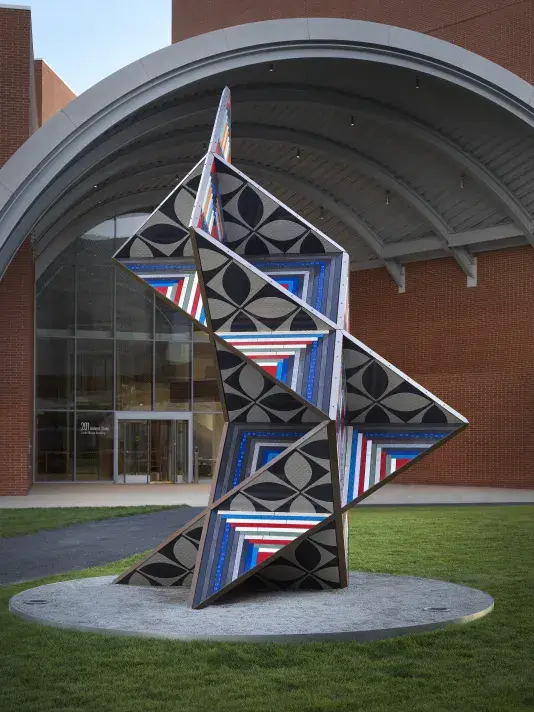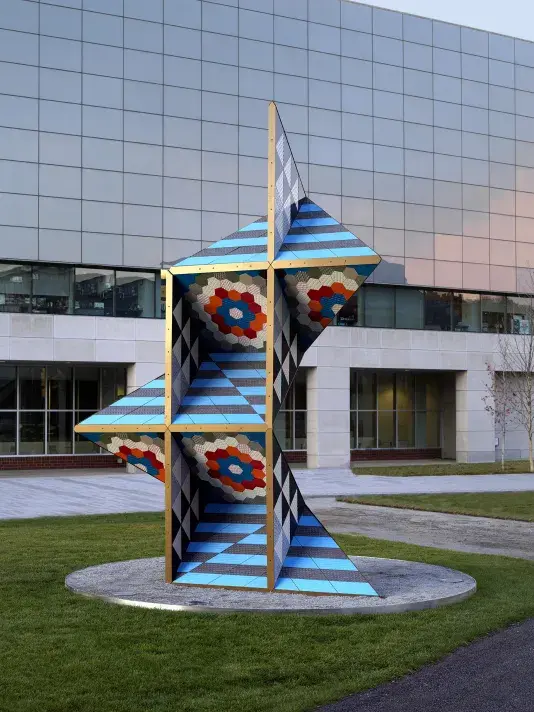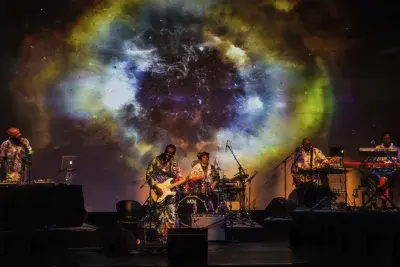Sanford Biggers, Madrigal, 2024. Commissioned with MIT Percent-for-Art funds and a generous gift from Robert Sanders (’64) & Sara-Ann Sanders. Photo: Dario Lasagni
Madrigal, 2024

Madrigal (2024), a vibrantly patterned outdoor sculpture by Sanford Biggers, is the Percent-for-Art commission for the Institute’s new Edward and Joyce Linde Music Building (Building W18) designed by Sejima and Nishizawa and Associates (SANAA).
The sculpture’s exuberant, colorful geometry and bold tessellation are drawn from Biggers’s Codex series (2009-ongoing), in which the artist transforms antique quilts into striking new mixed-media paintings and sculptural compositions that complicate the histories they bear. Biggers, who is attracted to quilts for their vernacular artistry and as everyday domestic objects, has studied pre-1900 versions and the long-debated historical narrative that certain patterns functioned as semaphores, conveying coded messages along the Underground Railroad to aid enslaved people in their flight to emancipated territories. When creating with found or vintage quilts, Biggers considers himself a “late collaborator” of the quilts’ unknown creators, and his works augment their expert needlecraft and encoded stories with wide-ranging aesthetic traditions.
The work’s title, Madrigal, is a type of song composed for multiple voices singing in counterpoint. The metaphor of polyphonic music is one with manifold references to the site—a building dedicated to the study of music—as well as to the deep, abiding influence of music on Biggers’s approach to art. In addition to his visual practice, the artist fronts the concept band Moonmedicin, and he has often likened his art-making methods to those of a DJ sampling different tracks to create a new sound. With Madrigal, dazzling visual harmonies (and discordances) are created as the work’s complex geometry enfolds six distinct quilt patterns into seemingly endless configurations. Standing over eighteen feet high, Madrigal reconsiders Biggers’s earlier textile sculptures at a monumental scale, while its origami-like forms allude to features of Japanese culture that have influenced the artist since his years living in Japan.
Madrigal translates patterns patchworked in textiles into durable, boldly colored tiles with milled surfaces that replicate the tactile qualities of various fabrics. And just as scrap textiles are often used for quilting, Biggers sourced remnant materials left over from architectural projects for the sculpture’s surface. The specific colors and finishes were selected by the artist to complement SANAA’s Music Building, resonating with the material and structural choices of neighboring buildings, including the Kresge Auditorium and Eero Saarinen’s iconic MIT Chapel. Through borrowing and reinterpreting visual styles from myriad references and symbols, Biggers remains attuned to the context in which his work exists. As the artist has articulated, he aims to imbue “the original function and meaning of historical objects with new significance from [and for] contemporary culture, [the] world, and society.”
Sanford Biggers (b. 1970) was raised in Los Angeles and currently lives and works in New York City. His work has been presented in solo exhibitions at the Bronx Museum of the Arts, New York (2021); Contemporary Art Museum St. Louis, MO (2018); the Museum of Contemporary Art Detroit, MI (2016); MASS MoCA, North Adams, MA (2012); and the Brooklyn Museum, New York (2011); among others. Additionally, his work has been presented in group exhibitions at the Menil Collection, Houston, TX (2008), the Tate Modern, London (2007), and, more recently, at the Smithsonian American Art Museum, Washington, DC (2024), the Barbican Center, London (2024), Centre Pompidou-Metz, France (2023), the Metropolitan Museum of Art, New York (2017), and the Barnes Foundation, Philadelphia, PA (2017).
Biggers is the recipient of numerous awards, including “2024 Best Alternative Jazz Album” at the Grammy Awards for his contribution to Meshell Ndgeocello’s The Omnichord Real Book. He received an honoree doctorate from the School of the Art Institute of Chicago in 2024; he was also an honoree at the Bronx Museum Gala and Art Auction, New York, in 2024. The artist is a National Academician in the Class of 2023, National Academy of Design, New York. He also received a Smithsonian Artist Research Fellowship (2023–24); a Bennie Trailblazer Award, Morehouse College, GA (2024); the Savannah College of Art and Design’s deFINE Art Award (2021); a 2020 Guggenheim Fellowship; an American Academy of Arts and Letters Award (2018); and the Rome Prize in Visual Arts in 2017. Biggers was additionally the 2021–22 Dr. Martin Luther King, Jr., Visiting Professor and Scholar in the MIT Department of Architecture.
Sanford Biggers was selected for the commission by Percent-for-Art committee members, including Richard Amster, Director, MIT Campus Construction; Paul C. Ha, Director, MIT List Visual Arts Center; Joyce Linde, Trustee, Linde Family Foundation; Keeril Makan, Section Head and Michael (‘49) and Sonja Koerner Music Composition Professor, MIT Music and Theater Arts; Vasso Mathes, Senior Campus Planner, MIT Office of Campus Planning; Melissa Nobles, Dean, MIT School of Humanities, Arts, and Social Sciences; Sonia Richards, Director of Capital Projects, MIT Campus Construction; Kim Sutherland, CRSP Space Liaison, MIT Office of the Provost; Yumiko Yamada, Partner, SANAA; Sarah Yazici, Senior Project Manager, MIT Campus Construction. The Institute gratefully acknowledges the generous gift from Robert Sanders (‘64) and Sara-Ann Sanders in support of the artwork.


